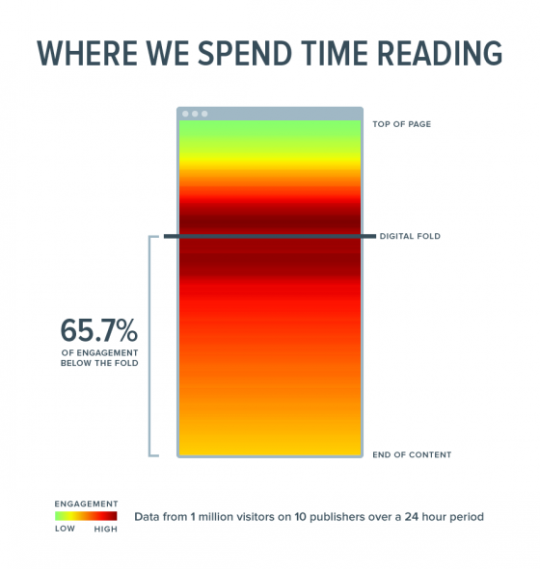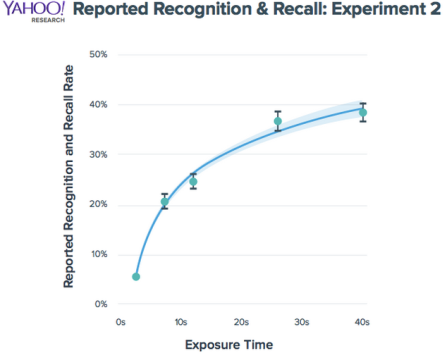It’s Time to Forget the Fold

If you work with digital ads, you are no doubt familiar with the “fold” – the place where the user’s screen cuts off the content, and scrolling is required to view more. (It’s an anachronistic term from the newspaper days, when stories above the fold in the middle of the page were more prominent than those below.) Many advertising contracts specify “above the fold” placement on web pages, although exactly where that fold occurs depends on a variety of factors like screen resolution, browser window dimensions, etc.
It’s understandable why advertisers demand placement near the top of the page. In 2010, user experience expert Jakob Nielsen published data showing that 80% of user time on a page was spent above the fold. In other words, the top of the page got all the attention, and ads initially out of view would get little or no attention. Here is the eye-tracking backup for that assertion:

Now, however, it seems that user behavior is changing. Or, we have better ways to measure it. In a recent TIME article, What You Think You Know About the Web Is Wrong, Chartbeat CEO Tony Haile (@arctictony) upends the “above the fold” gospel by noting,

66% of attention on a normal media page is spent below the fold. That leaderboard at the top of the page? People scroll right past that and spend their time where the content not the cruft is.
And that’s not all… Haile writes about a growing shift to the “Attention Web,” in which traditional metrics like impressions, clicks, and pageviews are far less important than the degree to which the visitor engages with the content. In a new article at Digiday, Debunking the myths of the attention Web, he offers evidence of this phenomenon from Yahoo testing:

Haile points out that one can use this data to fuel different strategies. One long ad exposure is good, but switching the ad partway through would have even better recall. He acknowledges the reality of banner blindness, but says that great creative will still attract visitor attention.
The conclusion one can draw is that the coveted top-of-page leaderboard isn’t so desirable after all. First, users may tune it out due to experience-based banner blindness. They have learned that the long rectangle at the top of the page is usually irrelevant to what they visited the page for.
Second, the top placement will get exposed to everyone who visits the page, but those impressions will include plenty of disengaged visitors who are about to hit the back button, click away, or close the window. Even those visitors who will ultimately engage with the content may not be “hooked” yet.
Blogger Lessons
Ask experienced bloggers who have optimized their list-building efforts what the best-converting location for a “subscribe” box is and they’ll never answer “a top banner ad.” The most common answer I’ve received is “at the end of the post, when the visitor knows you are offering good content.”
Subscriptions are a special case, of course, but the success of this spot reflects the high level of attention from an interested reader.
In short, it’s time to start thinking “below the fold” to maximize ad impact. As a bonus, some publishers sell these previously undesirable spots at big discounts – that will increase the ROI of these placements even more.
What has your experience been with ad placements? Do you still focus on above-the-fold, or have you achieved better results with less traditional locations?
